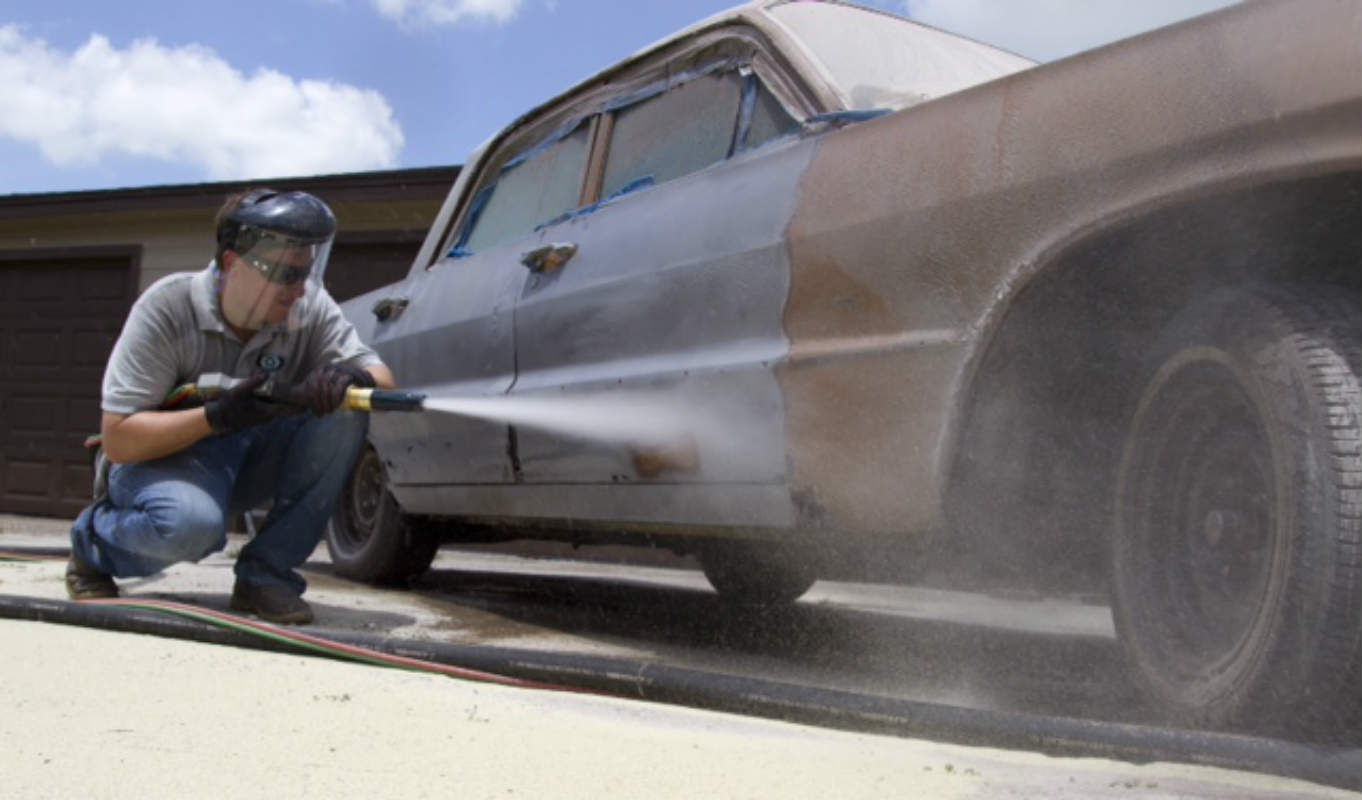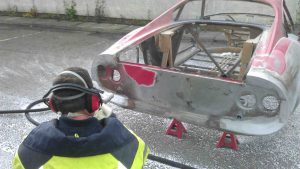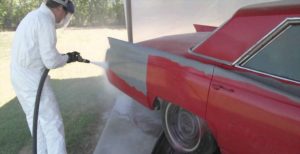Differences of Sandblasting, Soda Blasting or Dustless Sandblasting Your Vehicle
When it comes to stripping paint, rust, oil and grease from the steel body of a car, a variety of methods can be used, but some of the most common are sandblasting, soda blasting and dustless sandblasting. Sandblasting uses sand particles alone to scrape the surface of a vehicle with small particles propelled at a high pressure. Soda blasting uses sodium bicarbonate, otherwise known as baking soda. Dustless sandblasting is the same as sandblasting with the addition of water and usually a rust inhibitor.
Which Method Is Best for the Steel Body of a Car?
Out of the three methods, dustless sandblasting is better for steel because the water in it reduces friction and heat, which can warp the metal during the stripping process. According to Dustless Blasting, the original manufacturer of dustless sandblasting equipment, dustless sandblasting can actually lower the temperature of the metal by 10 degrees while the process is being performed. By contrast, normal sandblasting will produce heat and friction, and the metal can be subject to warping because of this, especially if it’s thin. Some people have taken to applying a cooler to the sand during this work to help mitigate this effect. Dustless Blasting also claims that while soda blasting won’t warp steel because it doesn’t create enough friction, it will create dust that can kill plants and grass if it’s used outside; fortunately, baking soda is nontoxic for humans.
How Are the Methods Employed?
The first step in the process is for a car owner to figure out which parts of the vehicle body need to be blasted. According to eHow, if sandblasting is being employed and the part being blasted is an underbody part, a bleached and washed sand should be used. For visible surface parts, such as door panels, 36-grit silica sand should be utilized. If possible, parts of the car not being blasted should be removed and kept in isolation. These include panel strips, door handles, taillights and other parts that are not undergoing the refinishing process. Contrary to popular belief, taping over parts is not a good enough solution because the particles may erode the tape or get underneath it. If possible, the parts being blasted should themselves be isolated, and a tarp should be used underneath to catch the particles and dust.
Dustless Blasting claims that dustless sandblasting is faster and easier than soda blasting. On the other hand, as far as cleanup, soda particles can typically be washed away whereas sand and dustless sand particles can be recycled and need much more cleanup time. According to Jalopy Journal, in many cases, the sand or soda can stay in joints and cracks of the car body long after the work has been performed. For this reason, extra attention should be paid to holes, nooks and crannies in the areas being worked on.
Which Method Works Best When It Comes to Body Work and Painting a Vehicle?
Soda blasting and sandblasting create dust, which can get inside the vehicle and into body parts. Baking soda is technically an alkaline chemical, and the particles are so small that they get into the pores of the metal. Soda blasting companies often leave a protective film on a car’s surface to prevent flash rusting, and this can have a negative impact on epoxying or prime coating a car prior to painting because the epoxy or primer peels away from the surface. Therefore, to remove this film, grinding must be used, or the film can be neutralized with warm, soapy water and a scuff pad. Some people perform the latter process at a car wash. Others recommend adding vinegar to the mix and using Scotch Brite afterward. A good number of people have reported negative experiences trying to paint soda-blasted cars, mostly because the film was not removed or neutralized prior to painting. Car owners should be careful as having to re-do a paint job can cost thousands of dollars. People who did not perform this step have had to paint their cars multiple times at great cost. Often, they blame the soda blasting process when, in fact, they did not prep their vehicle enough prior to painting.
Which Method Works Best on Rust, Paint, Oil and Grease, and Which Method Is the Least Costly?
Sandblasting is an excellent process for removing rust from car bodies, but it’s not as effective as dustless sandblasting for removing paint. Soda blasting is typically not as effective at removing either paint or rust compared to sandblasting or dustless sandblasting because it’s not as heavy duty a medium. Typical dustless sandblasting incorporates a rust inhibitor that decontaminates the steel, leaving a chloride-free, clean and paint-ready surface. A pressure setting of 70 PSI is recommended for dustless sandblasting at about a 20-degree angle. To know which method will work best on a vehicle, the person making the decision should look it over and see which of the above conditions affect the car’s body. If a vehicle has high amounts of rust, a heavier-duty solution will likely be needed over soda blasting. If the body is already relatively rust-free and the owner knows how to deal with the protective film that is applied afterward, soda blasting may be the way to go. Sandblasting is the cheapest of the three methods, followed by dustless sandblasting. Sand for children’s sandboxes is commonly employed for sandblasting although more technical or alternative media options are also available. Soda blasting uses expensive material and therefore is the most costly method of the three.
How Long After Blasting Can One Wait Before Starting on Body Work or Painting a Vehicle?
A common question is how much time can elapse between the blasting of a vehicle and its preparation for painting. The answer is that it depends on the method of blasting being employed. If sandblasting or dustless sandblasting is utilized, the bodywork or painting of the vehicle can be performed as soon as the surface is clean. However, according to website FlashRust.org, in a humid environment, flash rusting can happen within minutes to hours of blasting. The climate and geographical location where the work is being performed can greatly affect humidity levels as can indoor environments where moisture is prevalent. Any rust must be cleaned immediately prior to beginning bodywork or painting. In humid environments, the sooner bodywork or painting is begun, the better. With soda blasting, the surface is usually protected by a film applied to remove the soda from the metal when the process is finished. Because of this, the owner can wait as long as they want to begin the work; they just have to remember to either remove or neutralize the film before applying epoxy or primer.
There are multiple methods to removing paint, rust or grease from the body of a vehicle, but no one method is superior. Car owners should carefully consider the advantages and challenges for each type of blasting to select the best option for their vehicle.










I have been wanting to fix up an old car of mine so I’m considering getting it sandblasted before I put the new paint on. I like your point about how the water is this method helps reduce friction and heat. This sounds like the best way to avoid warping the metal so I’ll be sure to ask about this when it comes time to paint it.
I find it interesting that you said that getting a vehicle’s body sandblasted would help reduce friction and heat and prevent the metal from warping. When you said that, it reminded me how my uncle wants to fly in his mini airplane again. Reading your article convinced me to send it down to the machine shop this week so that I could surprise him next week to help him live out his teenage dream.
It’s good to know that sandblasting is an excellent process for removing rust from car bodies. My brother has some rust that’s built up on his car over time that he wants to get removed. I’ll pass this information along to him so that he can look further into his sandblasting options.
It’s good to know that sandblasting is an excellent way to remove rust from a car body. My brother has noticed that there’s some rust creeping up around his wheels. I’ll pass this information along to him so that he can look into his options for getting his car sandblasted to remove that rust.
I appreciate what you said about leaving a chloride-free, clean and paint-ready surface. My wife and I want our car to be redone because it is super beat up. I’ll have to consider getting it to an auto shop to fix all the dents.
Had 9 parts Soda blasted last week and at the paint store we heard the scare about the residue, the article was extremely helpful and relieved a lot of the anxiety. So as long as we clean the metal properly we shouldn’t have any trouble. Can only say my stomach sank to the body with what we heard. Thank you so much for the advice.
such an amazing article. so much information about sandblasting machines, sandblasting process, sandblasting abrasives. It really helps me in my industrial equipment business.
Thanks once again
Thanks for sharing differences of sandblasting soda blasting or dustless sandblasting your vehicle it not just for me but for everyone.I would like to thank you for the efforts you have made in writing this article.
That distinction does it for me and me upcoming project.
Thanks for sharing
I really loved reading your thoughts; obviously you know what you are talking about topic”DIFFERENCES OF SANDBLASTING, SODA BLASTING OR DUSTLESS SANDBLASTING YOUR VEHICLE”. Go for information website https://www.elitewaterblasting.co.nz/. I like your post. Keep write a new post.